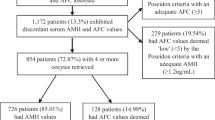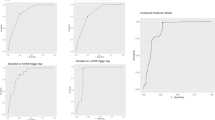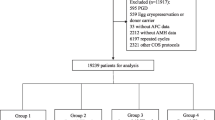Abstract
Purpose
To evaluate the capacity of random antral follicle count (AFC), i.e., AFC recorded at any time during the menstrual cycle, to predict the number of retrieved mature oocytes in women with malignancies undergoing random start ovarian hyperstimulation
Methods
A consecutive series of 72 women with malignancies who underwent ovarian hyperstimulation aimed at egg freezing between July 2014 and December 2016 was retrospectively reviewed. A standardized random start protocol was used for all women. AFC and serum AMH were systematically assessed prior to initiating ovarian hyperstimulation. The main outcome was the retrieval of ≥ 10 mature oocytes. The accuracy of random AFC was tested with the c-statistics (area under the ROC curve).
Results
For the whole cohort, the c-statistics for the prediction of ≥ 10 mature oocytes using AFC and serum AMH were similar. Specifically, the areas under the curve were 0.76 (95%CI 0.66–0.87) and 0.82 (95%CI 0.72–0.92), respectively (p = ns). Moreover, when considering the subgroup of women recruited after day 5 of the cycle (proper random start, n = 52), the areas under the curve did not also differ. Specifically, they resulted in 0.77 (95%CI 0.64–0.89) and 0.83 (95%CI 0.72–0.95), respectively (p = ns).
Conclusions
AFC collected at any time during the menstrual cycle can provide valuable information for the counseling of women with malignancies scheduled for oocyte cryopreservation. Its reliability appears to be non-inferior to that of serum AMH.



Similar content being viewed by others
References
Loren AW, Mangu PB, Beck LN, Brennan L, Magdalinski AJ, Partridge A, et al. For patients with cancer: American Society of Clinical Oncology clinical practice guideline update. J Clin Oncol. 2013;31:2500–10.
Linkeviciute A, Boniolo G, Chiavari L, Peccatori FA. Fertility preservation in cancer patients: the global framework. Cancer Treat Rev. 2014;40:1019–27.
De Vos M, Smitz J, Woodruff TK. Fertility preservation in women with cancer. Lancet. 2014;384:1302–10.
Chan JL, Johnson LN, Efymow BL, Sammel MD, Gracia CR. Outcomes of ovarian stimulation after treatment with chemotherapy. J Assist Reprod Genet. 2015;32:1537–45.
Fisch B, Abir R. Female fertility preservation: past, present and future. Reproduction. 2018;156:F11–27.
Alvarez RM, Ramanathan P. Fertility preservation in female oncology patients: the influence of the type of cancer on ovarian stimulation response. Hum Reprod. 2018;33:2051–59.
Lefebvre T, Mirallié S, Leperlier F, Reignier A, Barrière P, Fréour T. Ovarian reserve and response to stimulation in women undergoing fertility preservation according to malignancy type. Reprod BioMed Online. 2018;37:201–7.
Peccatori FA, Mangili G, Bergamini A, Filippi F, Martinelli F, Ferrari F, et al. Fertility preservation in women harboring deleterious BRCA mutations: ready for prime time? Hum Reprod. 2018;33:181–7.
Broer SL, van Disseldorp J, Broeze KA, Dolleman M, Opmeer BC, Bossuyt P, et al. Added value of ovarian reserve testing on patient characteristics in the prediction of ovarian response and ongoing pregnancy: an individual patient data approach. Hum Reprod Update. 2013;19:26–36.
Cobo A, García-Velasco JA, Coello A, Domingo J, Pellicer A, Remohí J. Oocyte vitrification as an efficient option for elective fertility preservation. Fertil Steril. 2016;105:755–64.
Nelson SM. Biomarkers of ovarian response: current and future applications. Fertil Steril. 2013;99:963–9.
Li HW, Wong BP, Ip WK, Yeung WS, Ho PC, Ng EH. Comparative evaluation of three new commercial immunoassays for anti-Müllerian hormone measurement. Hum Reprod. 2016;31:2796–802.
Lee S, Ozkavukcu S, Heytens E, Moy F, Alappat RM, Oktay K. Anti-Mullerian hormone and antral follicle count as predictors for embryo/oocyte cryopreservation cycle outcomes in breast cancer patients stimulated with letrozole and follicle stimulating hormone. J Assist Reprod Genet. 2011;28:651–6.
Martins WP, Kollmann M, Raine-Fenning N. Counting ovarian follicles: updated threshold for diagnosis of hyperandrogenic anovulation. Ultrasound Obstet Gynecol. 2014;44:131–4.
van Disseldorp J, Lambalk CB, Kwee J, Looman CW, Eijkemans MJ, Fauser BC, et al. Comparison of inter and intra-cycle variability of anti-Mullerian hormone and antral follicle counts. Hum Reprod. 2010;25:221–7.
Mavrelos D, Al Chami A, Talaulikar V, Burt E, Webber L, Ploubidis G, et al. Variation in antral follicle counts at different times in the menstrual cycle: does it matter? Reprod BioMed Online. 2016;33:174–9.
Rombauts L, Onwude JL, Chew HW, Vollenhoven BJ. The predictive value of antral follicle count remains unchanged across the menstrual cycle. Fertil Steril. 2011;96:1514–8.
Broekmans FJ, De Ziegler D, Howles CM, Gougeon A, Trew G, Olivennes F. The antral follicle count: practical recommendations for better standardization. Fertil Steril. 2010;94:1044–51.
Cakmak H, Katz A, Cedars MI, Rosen MP. Effective method for emergency fertility preservation: random-start controlled ovarian stimulation. Fertil Steril. 2013;100:1673–80.
Grynberg M, Poulain M, le Parco S, Sifer C, Fanchin R, Frydman N. Similar in vitro maturation rates of oocytes retrieved during the follicular or luteal phase offer flexible options for urgent fertility preservation in breast cancer patients. Hum Reprod. 2016;31:623–9.
Bossuyt PM, Reitsma JB, Bruns DE, Gatsonis CA, Glasziou PP, Irwig LM, et al. The STARD statement for reporting studies of diagnostic accuracy: explanation and elaboration. Ann Intern Med. 2003;138:W1–12.
Rienzi L, Cobo A, Paffoni A, Scarduelli C, Capalbo A, Vajta G, et al. Consistent and predictable delivery rates after oocyte vitrification: an observational longitudinal cohort multicentric study. Hum Reprod. 2012;27:1606–12.
Sarais V, Paffoni A, Pagliardini L, Filippi F, Martinelli F, Mangili G, et al. Long-acting recombinant follicle-stimulating hormone in random-start ovarian stimulation protocols for fertility preservation in women with cancer. Acta Obstet Gynecol Scand. 2017;96:949–53.
Schattman GL. Cryopreservation of oocytes. N Engl J Med. 2015;373:1755–60.
Somigliana E, Lattuada D, Colciaghi B, Filippi F, La Vecchia I, Tirelli A, et al. Serum anti-Müllerian hormone in subfertile women. Acta Obstet Gynecol Scand. 2015;94:1307–12.
La Marca A, Grisendi V, Griesinger G. How much does AMH really vary in normal women? Int J Endocrinol. 2013;2013:959487.
Nastri CO, Teixeira DM, Moroni RM, Leitao VM, Martins WP. Ovarian hyperstimulation syndrome: pathophysiology, staging, prediction and prevention. Ultrasound Obstet Gynecol. 2015;45:377–93.
Iliodromiti S, Anderson RA, Nelson SM. Technical and performance characteristics of anti-Müllerian hormone and antral follicle count as biomarkers of ovarian response. Hum Reprod Update. 2015;21:698–710.
Quinn MM, Cakmak H, Letourneau JM, Cedars MI, Rosen MP. Response to ovarian stimulation is not impacted by a breast cancer diagnosis. Hum Reprod. 2017;32:568–74.
Metzger ML, Meacham LR, Patterson B, Casillas JS, Constine LS, Hijiya N, et al. Female reproductive health after childhood, adolescent, and young adult cancers: guidelines for the assessment and management of female reproductive complications. J Clin Oncol. 2013;31:1239–47.
Birch Petersen K, Hvidman HW, Forman JL, Pinborg A, Larsen EC, Macklon KT, et al. Ovarian reserve assessment in users of oral contraception seeking fertility advice on their reproductive lifespan. Hum Reprod. 2015;30:2364–75.
Benaglia L, Candotti G, Busnelli A, Paffoni A, Vercellini P, Somigliana E. Antral follicle count as a predictor of ovarian responsiveness in women with endometriomas or with a history of surgery for endometriomas. Fertil Steril. 2015;103:1544–50.
Lima ML, Martins WP, Coelho Neto MA, Nastri CO, Ferriani RA, Navarro PA. Assessment of ovarian reserve by antral follicle count in ovaries with endometrioma. Ultrasound Obstet Gynecol. 2015;46:239–42.
La Marca A, Sighinolfi G, Radi D, Argento C, Baraldi E, Artenisio AC, et al. Anti-Mullerian hormone (AMH) as a predictive marker in assisted reproductive technology (ART). Hum Reprod Update. 2010;16:113–30.
Subirá J, Alberola-Rubio J, Núñez MJ, Escrivá AM, Pellicer A, Montañana V, et al. Inter-cycle and inter-observer variability of the antral follicle count in routine clinical practice. Gynecol Endocrinol. 2017;33:515–8.
Broer SL, Broekmans FJ, Laven JS, Fauser BC. Anti-Müllerian hormone: ovarian reserve testing and its potential clinical implications. Hum Reprod Update. 2014;20:688–701.
Author information
Authors and Affiliations
Corresponding author
Ethics declarations
Conflict of interest
Edgardo Somigliana received during the last 3 years grants of research from Ferring and Merck-Serono. All the other authors do not have any financial disclosure to declare.
Rights and permissions
About this article
Cite this article
Filippi, F., Martinelli, F., Paffoni, A. et al. Fertility preservation in women with malignancies: the accuracy of antral follicle count collected randomly during the menstrual cycle in predicting the number of oocytes retrieved. J Assist Reprod Genet 36, 569–578 (2019). https://doi.org/10.1007/s10815-018-1377-0
Received:
Accepted:
Published:
Issue Date:
DOI: https://doi.org/10.1007/s10815-018-1377-0




